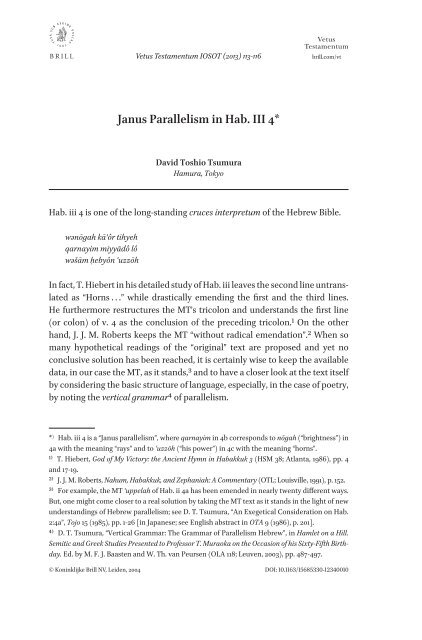Special Issue IOSOT 2013 - Books and Journals
Special Issue IOSOT 2013 - Books and Journals
Special Issue IOSOT 2013 - Books and Journals
Create successful ePaper yourself
Turn your PDF publications into a flip-book with our unique Google optimized e-Paper software.
Vetus Testamentum <strong>IOSOT</strong> (<strong>2013</strong>) 113-116<br />
Vetus<br />
Testamentum<br />
brill.com/vt<br />
Janus Parallelism in Hab. Iii 4*<br />
David Toshio Tsumura<br />
Hamura, Tokyo<br />
Hab. iii 4 is one of the long-st<strong>and</strong>ing cruces interpretum of the Hebrew Bible.<br />
wənōgah kāʾôr tihyeh<br />
qarnayim miyyādô lô<br />
wəšām ḥebyôn ʿuzzōh<br />
In fact, T. Hiebert in his detailed study of Hab. iii leaves the second line untranslated<br />
as “Horns . . .” while drastically emending the first <strong>and</strong> the third lines.<br />
He furthermore restructures the MT’s tricolon <strong>and</strong> underst<strong>and</strong>s the first line<br />
(or colon) of v. 4 as the conclusion of the preceding tricolon.1 On the other<br />
h<strong>and</strong>, J. J. M. Roberts keeps the MT “without radical emendation”.2 When so<br />
many hypothetical readings of the “original” text are proposed <strong>and</strong> yet no<br />
conclusive solution has been reached, it is certainly wise to keep the available<br />
data, in our case the MT, as it st<strong>and</strong>s,3 <strong>and</strong> to have a closer look at the text itself<br />
by considering the basic structure of language, especially, in the case of poetry,<br />
by noting the vertical grammar4 of parallelism.<br />
* ) Hab. iii 4 is a “Janus parallelism”, where qarnayim in 4b corresponds to nōgah (“brightness”) in<br />
4a with the meaning “rays” <strong>and</strong> to ʿuzzōh (“his power”) in 4c with the meaning “horns”.<br />
1) T. Hiebert, God of My Victory: the Ancient Hymn in Habakkuk 3 (HSM 38; Atlanta, 1986), pp. 4<br />
<strong>and</strong> 17-19.<br />
2) J. J. M. Roberts, Nahum, Habakkuk, <strong>and</strong> Zephaniah: A Commentary (OTL; Louisville, 1991), p. 152.<br />
3) For example, the MT ʿuppelah of Hab. ii 4a has been emended in nearly twenty different ways.<br />
But, one might come closer to a real solution by taking the MT text as it st<strong>and</strong>s in the light of new<br />
underst<strong>and</strong>ings of Hebrew parallelism; see D. T. Tsumura, “An Exegetical Consideration on Hab.<br />
2:4a”, Tojo 15 (1985), pp. 1-26 [in Japanese; see English abstract in OTA 9 (1986), p. 201].<br />
4) D. T. Tsumura, “Vertical Grammar: The Grammar of Parallelism Hebrew”, in Hamlet on a Hill.<br />
Semitic <strong>and</strong> Greek Studies Presented to Professor T. Muraoka on the Occasion of his Sixty-Fifth Birthday.<br />
Ed. by M. F. J. Baasten <strong>and</strong> W. Th. van Peursen (OLA 118; Leuven, 2003), pp. 487-497.<br />
© Koninklijke Brill NV, Leiden, 2004 DOI: 10.1163/15685330-12340010








![Am HaSefer [Volk des Buches] - Books and Journals](https://img.yumpu.com/20648352/1/174x260/am-hasefer-volk-des-buches-books-and-journals.jpg?quality=85)







